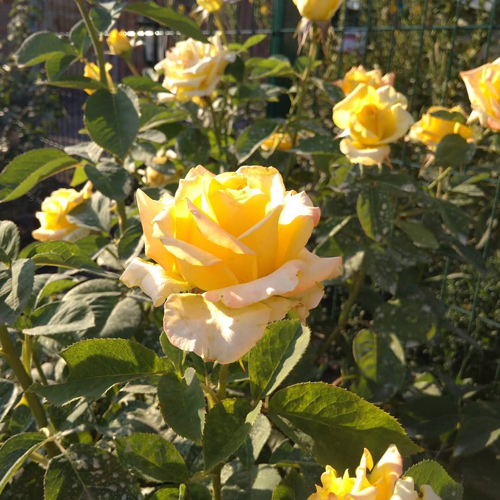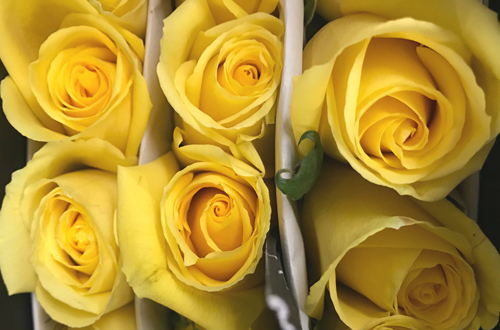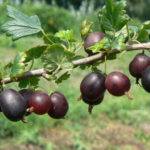Rose of Mohana (Mohana)
Today, few people associate yellow roses with separation, betrayal and deception. This stereotype is almost irrevocably a thing of the past. For a modern person, a noble plant with yellow buds serves as a symbol of success and material well-being. The Mohana rose variety can be easily recognized as its embodiment.

History of origin
Mohana belongs to the group of tea hybrids, but was bred as a variety intended primarily for cutting. This variety of roses appeared relatively recently - in 2006. It was created by the German breeder Hans Jürgen Evers, who works in the famous German nursery Rosen Tantau. The registration name of the flower is Tan02066.
Description of the variety
Mohana is a short, compact shrub, prone to branching, with straight, strong stems, densely covered with dark green matte leaves. The width of its crown is about 60 cm. The perennial reaches a height of 0.8 - 1 m, no more. On each stem of the plant, a dense tall bud of a classic goblet shape is formed, consisting of 40 - 45 petals. The flowers of the culture are double, medium-sized (7 - 9 cm in diameter), bright, lemon-yellow hue. Sometimes on the edges of delicate petals, you can notice the presence of a slight blush. The pleasant impression produced by this variety is complemented by a delicate aroma with pronounced honey notes.
A beautiful German woman will delight her owner with abundant and lush flowering, which lasts until the first frost, with almost continuous throughout the summer season. Each flower stays on the bush for up to 12 days. This culture has an average resistance to diseases (primarily to black spot and powdery mildew), the appearance of its spectacular flowers does not deteriorate from rain and sunlight. The variety is characterized by good winter hardiness: the plant feels comfortable when the air temperature drops to minus 23.5 ºС.

Features of agricultural technology
The tea hybrid should be planted in a place where there is a lot of diffused sunlight during the day. When growing a crop in the shade, the bright color of perennial buds may suffer, and the flowering itself will not be too abundant. You can not place a rose in the lowlands, since there it will be subjected to the destructive influence of cold air. Drafts are also contraindicated in a rose bush. It is recommended to choose the soil for planting Mohana fertile, loose, light, with a pH in the range of 5.6 - 7.3. A hole in the site is dug with a depth and width of about 50 cm, since it is necessary to ensure the free location of the root system of the seedling in it. At the bottom of the pit, a layer of drainage material must be laid: a mixture of small pebbles and sand. By the way, the soil mixture for this plant can be prepared independently by combining 1 part of peat, 2 parts of sand, the same amount of sod land and 3 parts of humus. The right time to plant a flower is mid-spring.
The owner of lemon-yellow buds requires regular watering with settled water at room temperature. This procedure should be performed at intervals of 1 - 2 times a week. The plan of measures for the care of the crop also includes loosening the soil under the flower and mulching the soil in the area of the trunk circle. The plant also needs feeding. During the period of active growth, the soil under the rose is fertilized with organic matter, and in the summer, when buds are formed on the bush and, next, flowers, they use mineral complexes. In the fall, before wintering, a decorative perennial needs to be fed with a potassium-phosphorus concentrate. With the onset of spring, sanitary pruning of the plant is performed. She is exposed to thin, dry, frozen and damaged shoots. During the summer, it is important to remove faded inflorescences and young growth in time.

It is better to cover the culture for the winter. First, you need to shorten all its branches, then spud the rose bush with dry soil or peat, and only then cover it with spruce branches or non-woven material.To reduce the likelihood of fungal diseases on the rose, it is sprayed with a fungicide solution several times over the summer. And so that the shrub is not attacked by aphids, leafworms and other pests, it is worthwhile to additionally process the shoots with an insecticidal preparation.
Use cases
The Mohana rose variety will be an excellent decoration for your flower garden, front garden, rose garden, garden. It is also used for landscaping parks, squares; territories at educational institutions and medical institutions. The crop is suitable for cultivation in flower beds, in ridges and mixborders. The tea hybrid can be safely planted in groups and in the company of miniature conifers, fragrant herbs, ornamental cereals or flowering mono- and perennials: cosmea, verbena, fragrant levkoy, phlox, irises, daylilies, bells, veronica, sage, lavender, boxwood, thuja , fescue, turf pike, Chinese miscanthus, spartina, geraniums, clematis, gypsophila, reed grass, forget-me-nots, cornflowers, juniper. Borders from plants of this variety, placed on the sides of garden paths, are obtained beautiful; low hedges look fresh and bright. Of roses, our heroine goes well with noble plants, whose buds are colored in any shades of yellow, red, as well as blue, lilac, white and purple. She looks amazing against the backdrop of a green lawn, near the facade of the house, near the gazebo, near the garden stairs and a bench.
Since Mohana is, first of all, a cut-off variety, it is very popular not only among landscape designers, but also among florists. From wonderful flowers of a sunny color on long peduncles, beautiful bouquets and other flower arrangements full of cheerfulness and at the same time tenderness are obtained, which are pleasant to receive as a gift for a birthday, anniversary, graduation and any other festive event.








